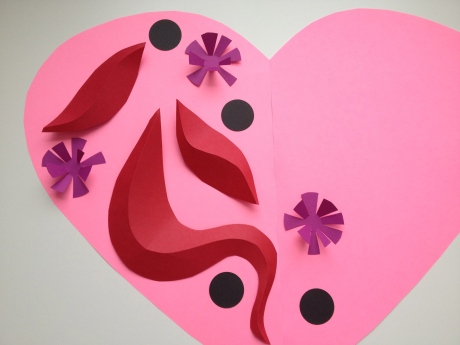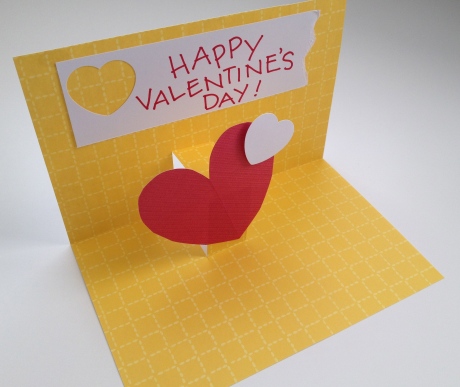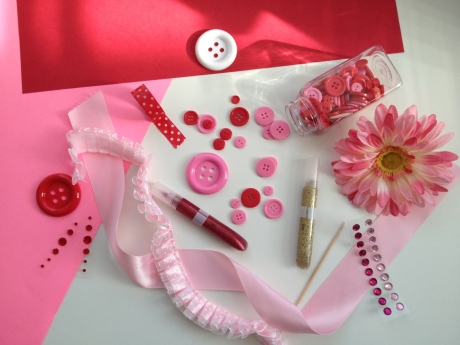 What better way to show we love the earth, than by creating some gorgeous Valentine’s Day inspired art work that encourages recycling as well?! Enter “Giant Stuffed Paper Hearts”.
What better way to show we love the earth, than by creating some gorgeous Valentine’s Day inspired art work that encourages recycling as well?! Enter “Giant Stuffed Paper Hearts”.
The materials for this spectacular art experience are outrageously simple. You will need butcher paper, “stuffing”, a stapler, any sort of decorative materials, glue, and string or fishing line. (If you have access to butcher paper in “Valentine” colors like pink, red, and purple, that’s great. If not, white and even black will work just as well.)
The idea here is that you are going to have your students cut giant — and I do mean giant — hearts out of butcher paper, decorate them, stuff them, and then hang them from the ceiling. (If your school won’t allow you to hang anything, these could just as easily be stapled to a wall where they will still look puffy and three dimensional.)
While you could use anything for the stuffing of the heart, this experience presents a perfect opportunity to talk about things like recycling, and campus beautification. If you are so inclined, you and your students might walk around the school yard collecting trash and bits of paper. (Gloves might be a good idea here.) Or maybe you could use paper from your own classroom that would normally be thrown in the trash? Newspapers collected from home work well here too. The point is, this art experience is tangible evidence that trash can be transformed again into something else — in this case, into something beautiful.
When cutting out their paper hearts, each child will need two hearts exactly alike, so you can show them how putting two pieces of paper together and cutting them out at the same time will accomplish this. (An alternative to this would be to have them cut out one giant heart, then trace that on to their second piece of butcher paper and then cut that one out.) Depending on how involved you want them to get, and on how you plan to display them, you can instruct your students to decorate only one side of one of their hearts, or one side of each of their hearts. I would really let them go wild here with lots and lots of different decorative materials. Things like paint, construction paper, tissue paper, crepe paper, glitter, lace, ribbons, yarn, buttons, cotton, etc. would all be super fun for the kids to work with. (Because the hearts are large, I would probably not put out any drawing tools for this one, as any drawing the children might do would tend to be small, and the surface decoration for these should really be bold and large.)
Once all surface decorations are finished and have been allowed to dry, place the two hearts together and begin stapling around the edge to connect them. (Staple at least one inch or so in from the edge.) Remember that if you had students decorate two sides, make sure each of those decorated sides face out, and that the plain sides are on the “inside”. After you’ve stapled about half way around the hearts, you may begin stuffing the heart with very loosely crumpled paper or trash. You want to keep these hearts very light, so there’s no need to stuff them full of tightly wadded paper. Use just enough lightly crumpled paper to “fill out” the heart and give it a puffy shape. Finish stapling the remainder of the edge to close the heart, and you’re done. The resulting hearts should be very light, so it will be easy to hang them from your ceiling if you choose to do so. Don’t worry about hanging them at the same height, because hanging them at different heights adds to the fun. You will be amazed at the magnificent display these create and your students will love them!
Share the love! If you decide to do this art experience with your students, I’d love to see the results. Email photos to me at JGomasFaison@gmail.com and with your permission I might even share some of your photos on this blog. Happy heart-making!
 Hello March! Even if the weather doesn’t quite feel like spring yet where you live, you know it’s just around the corner. And for teachers… that can only mean one thing: Spring Break! And just beyond that: Summer!
Hello March! Even if the weather doesn’t quite feel like spring yet where you live, you know it’s just around the corner. And for teachers… that can only mean one thing: Spring Break! And just beyond that: Summer!














